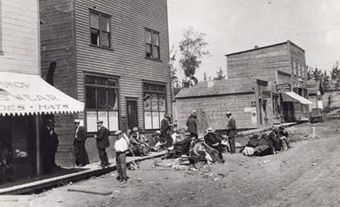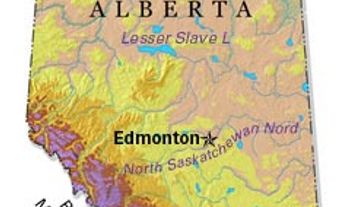Wood Buffalo
Wood Buffalo, incorporated as a regional municipality in 1995, population 65 565 (2011c), 51 496 (2006c). The Regional Municipality of Wood Buffalo was formed when the city of Fort McMurray (incorporated in 1980) amalgamated with Improvement District No 143, creating one of Canada’s largest municipalities by area. Stretching up from central Alberta along the province's eastern boundary to its northeast corner, the regional municipality is larger in area than Nova Scotia and Prince Edward Island combined. In addition to Fort McMurray, Wood Buffalo is comprised of a number of smaller communities: Fort MacKay, Fort Chipewyan, Fort Fitzgerald, Saprae Creek Estates, Draper, Anzac, Conklin, Gregoire Lake Estates, Janvier and Mariana Lake. It also encompasses Indian reserves determined under Treaty 8 and traditional lands of the Cree, Chipewyan and Métis. The Athabasca Tribal Council represents the interests of the 5 First Nations; the region has 7 Métis locals.
Fort McMurray is the largest urban service area in the regional municipality of Wood Buffalo. The vast majority of the region's population lives in subdivisions located in and around Fort McMurray, such as Timberlea, Thickwood Heights, Lower Townsite (Fort McMurray's historic centre), Abasand Heights, Beacon Hill, Gregoire and Water Ways. It is the region's centre for administration, service and trade.
Athabasca Oil Sands
Wood Buffalo is located on a 104 000 km2 deposit of oil sands, the largest of 3 deposits in Alberta (see Bitumen). Aboriginals knew of its existence and brought it to the attention of Henry Kelsey in 1719. They used the sticky oil to waterproof their canoes. Experimentation in oil recovery and its impact on the area's economy date from the early 20th century. In 1964 the Great Canadian Oil Sands (now Suncor Energy Inc) project was given permission to start construction and modern Fort McMurray was born. In 1974 Syncrude Canada began construction of an extraction plant, which officially opened 4 years later. This second project spurred more growth. The area was hit severely by the slump in world oil prices in 1986. However, although it experienced labour disputes, strikes and lockouts that year, the oil industry still managed to maintain and even better production levels.
A third growing phase began in the late 1990s and continues into the early part of this century with the approval of more major projects and the expansion of existing plants, which has resulted in two-thirds of Wood Buffalo's population working either directly for one of the oil companies, or for one of their contractors. Oil sands development is centered north of Fort McMurray and encircles Fort MacKay. The region has been bearing the socio-economic costs of this development. Public infrastructure and service delivery in Fort McMurray have been strained by growth. Increased demand has made housing both scarce and expensive.
In response to these pressures and to expected growth, Wood Buffalo has developed a collection of long range planning documents designed to look at land use within the entire region for the next 30 years when the population is expected to reach 250 000. The plans provide the municipality, citizens and industry with a clear direction regarding regional growth while maintaining a balance between economic, social, environmental and cultural concerns. Another initiative is the Future Forward Project, a multi-staged approach to developing a community-based vision for the future of Fort McMurray.
Cultural Life
The dominant community in Wood Buffalo, Fort McMurray has most of the region's cultural and educational institutions. Kenayo College provides post-secondary instruction. The region's main cultural venue is the college's theatre. Fort McMurray Today is its daily newspaper. Attractions include the Oil Sands Discovery Centre and Heritage Park in Fort McMurray, and the Bicentennial Museum in Fort Chipewyan. Interplay is a visual and performing arts festival held in August in Fort McMurray; and in February, Anzac hosts Winterfest featuring dogsled, snowmobile and cross-country ski races.

 Share on Facebook
Share on Facebook Share on X
Share on X Share by Email
Share by Email Share on Google Classroom
Share on Google Classroom


